Latium was the region of ancient Italy in which Rome was situated.
Latium may also refer to:
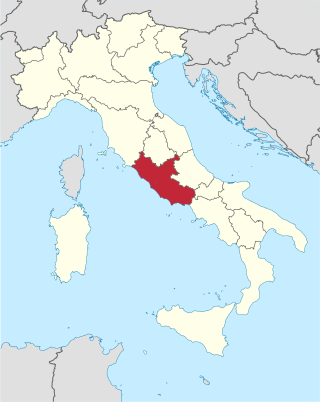
Lazio or Latium is one of the 20 administrative regions of Italy. Situated in the central peninsular section of the country, it has 5,714,882 inhabitants and a GDP of more than €197 billion per year, making it the country's second most populated region and second largest regional economy after Lombardy. The capital of Lazio is Rome, which is also the capital and largest city of Italy.
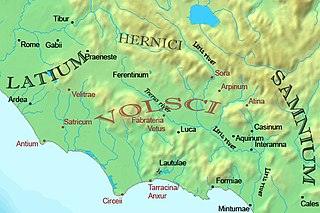
The Latins were originally an Italic tribe in ancient central Italy from Latium. As Roman power and colonization spread Latin culture during the Roman Republic. Latins culturally "Romanized" or "Latinized" the rest of Italy, and the word Latin ceased to mean a particular people or ethnicity, acquiring a more legal and cultural sense. As the Roman Empire spread to include Spain, Portugal, France, and Romania, these joined Italy in becoming "Latin" and remain so to the present day. In the 15th and 16th centuries, Portugal, Spain and France began to build world empires in the Americas, Africa and the East Indies. By the mid-19th century, the former American colonies of these Latin European nations became known as Latin America.
Cora may refer to:
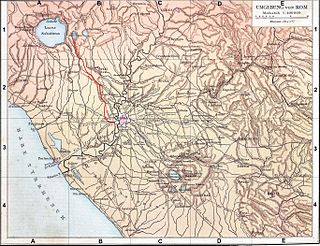
The Aniene, formerly known as the Teverone, is a 99-kilometer (62 mi) river in Lazio, Italy. It originates in the Apennines at Trevi nel Lazio and flows westward past Subiaco, Vicovaro, and Tivoli to join the Tiber in northern Rome. It formed the principal valley east of ancient Rome and became an important water source as the city's population expanded. The falls at Tivoli were noted for their beauty. Historic bridges across the river include the Ponte Nomentano, Ponte Mammolo, Ponte Salario, and Ponte di San Francesco, all of which were originally fortified with towers.

The Pontine Marshes is an approximately quadrangular area of former marshland in the Lazio Region of central Italy, extending along the coast southeast of Rome about 45 km (28 mi) from just east of Anzio to Terracina, varying in distance inland between the Tyrrhenian Sea and the Volscian Mountains from 15 to 25 km. The northwestern border runs approximately from the mouth of the river Astura along the river and from its upper reaches to Cori in the Monti Lepini.

Latin rights were a set of legal rights that were originally granted to the Latins under Roman law in their original territory and therefore in their colonies. "Latinitas" was commonly used by Roman jurists to denote this status. With the Roman expansion in Italy, many settlements and coloniae outside of Latium had Latin rights.

The Italic peoples were an ethnolinguistic group identified by their use of Italic languages, a branch of the Indo-European language family.
Antemnae was a town and Roman colony of ancient Latium in Italy. It was situated two miles north of ancient Rome on a hill commanding the confluence of the Aniene and the Tiber. It lay west of the later Via Salaria and now lies within a park in modern Rome.

Latium adiectum or Latium Novum was a region of Roman Italy between Monte Circeo and the river Garigliano, south of and immediately adjacent to Old Latium, hence its name of attached Latium.
Santa Paolina is a small comune (municipality) of the province of Avellino, in the region of Campania, Italy. It has a population of 1,360 as of 2014, down from 2,487 in 1951.

In the Archaic phase of ancient Greek art, the Orientalizing period or Orientalizing revolution is the cultural and art historical period that began during the later part of the 8th century BC, when there was a heavy influence from the more advanced art of the Eastern Mediterranean and the Ancient Near East. The main sources were Syria and Assyria as well as Phoenicia and Egypt. With the spread of Phoenician civilization by Carthage and Greek colonisation into the Western Mediterranean, these artistic trends also influenced the Etruscans and early Ancient Romans in the Italian peninsula.

Latium is the region of central western Italy in which the city of Rome was founded and grew to be the capital city of the Roman Empire.
Timothy J. Cornell is a British historian specializing in ancient Rome. He is an Emeritus Professor of Ancient History at the University of Manchester, having retired from his teaching position in 2011.
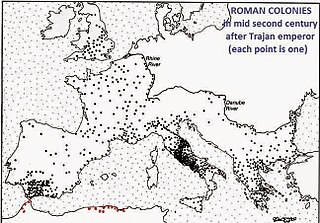
A Roman colonia was originally a Roman outpost established in conquered territory to secure it. Eventually, however, the term came to denote the highest status of a Roman city. It is also the origin of the modern term colony.

The prehistory of Italy began in the Paleolithic period, when species of Homo colonized the Italian territory for the first time, and ended in the Iron Age, when the first written records appeared in Italy.
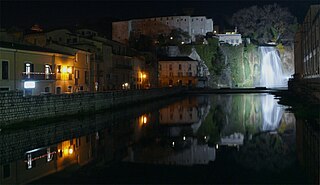
Valle Latina is an Italian geographical and historical region that extends from the south of Rome to Cassino, corresponding to the eastern area of ancient Roman Latium.
Saint Magnus of Anagni, also known as Magnus of Trani or Magnus of Fabrateria Vetus, is venerated as the patron saint of Anagni.

The Latins, sometimes known as the Latians, were an Italic tribe which included the early inhabitants of the city of Rome. From about 1000 BC, the Latins inhabited the small region known to the Romans as Old Latium, that is, the area between the river Tiber and the promontory of Mount Circeo 100 km (62 mi) southeast of Rome. Following the Roman expansion, the Latins spread into the Latium adiectum, inhabited by Osco-Umbrian peoples.

Old Latium is a region of the Italian peninsula bounded to the north by the river Tiber, to the east by the central Apennine mountains, to the west by the Mediterranean Sea and to the south by Monte Circeo. It was the territory of the Latins, an Italic tribe which included the early inhabitants of the city of Rome. Later it was also settled by various Italic tribes such as the Rutulians, Volscians, Aequi, and Hernici. The region was referred to as "old" to distinguish it from the expanded region, Latium, that included the region to the south of Old Latium, between Monte Circeo and the river Garigliano – the so-called Latium adiectum. It corresponded to the central part of the modern administrative region of Lazio, Italy, and it covered an area measuring of roughly 50 Roman miles. It was calculated by Mommsen that the region's area was about 1860 square kilometres.
The Venetulani number among the 53 peoples of Latium Vetus that Pliny the Elder records as having perished without leaving a trace. They are counted among the 30 Alban communities that carried out sacrificial activities on Mons Albanus. The name derives from a Veneti settlement which may have been called Venetulum.